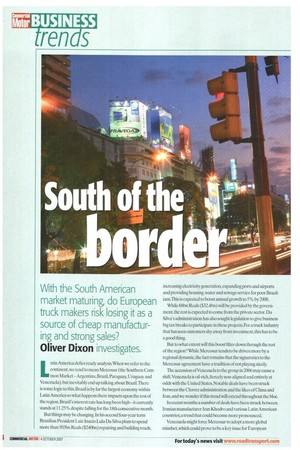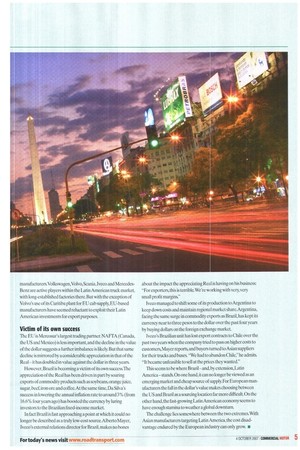With the South American market maturing, do European truck makers
Page 54

Page 55

If you've noticed an error in this article please click here to report it so we can fix it.
risk losing it as a source of cheap manufactur ing and strong sales?
Oliver Dixon investigates.
Latin America defies ready analysis. When we refer to the continent, we tend to mean Mercosur (the Southern Common Market —Argentina, Brazil, Paraguay, Uruguay and Venezuela), but inevitably end up talking about Brazil.There is some logic to this. Brazil is by far the largest economy within Latin America so what happens there impacts upon the rest of the region. Brazil's interest rate has long been high —it currently stands at 11.25% despite falling for the 18th consecutive month.
But things may be changing. In his second four-year term Brazilian President Luiz Inacio Lula Da Silva plans to spend more than 503bn Reals ($240bn) repairing and building roads, increasing electricity generation,expanding ports and airports and providing housing, water and sewage service for poor Brazilians.Tbis is expected to boost annual growth to 5% by 2008.
While 68bn Reals ($32.4bn) will be provided by the government, the rest is expected to come from the private sector. Da Silva's administration has also sought legislation to give business big tax breaks to participate in these projects. For a truck industry that has seen customers shy away from investment, this has to be a good thing.
But to what extent will this boost filter down through the rest of the region? While Mercosur tends to be driven more by a regional dynamic, the fact remains that the signatories to the Mercosur agreement have a tradition of not playing nicely.
The accession of Venezuela to the group in 2006 may cause a shift. Venezuela is oil-rich, fiercely non-aligned and entirely at odds with the United States. Notable deals have been struck between the Chavez administration and the likes of China and Iran, and we wonder if this trend will extend throughout the bloc.
In recent months a number of deals have been struck between Iranian manufacturer Iran Khodro and various Latin American countries; a trend that could become more pronounced.
Venezuela might force Mercosur to adopt a more global mindset, which could prove to be a key issue for European manufacturers.Volkswagen,Volvo,Scania,Iveco and MercedesBenz are active players within the Latin American truck market, with long-established factories there. But with the exception of Volvo's use of its Curitiba plant for EU cab supply,EU-based manufacturers have seemed reluctant to exploit their Latin American investments for export purposes.
Victim of its own success
The EU is N4ercosur's largest trading partner. NAFTA (Canada, the US and Mexico) is less important, and the decline in the value of the dollar suggests a further imbalance is likely. But that same decline is mirrored by a considerable appreciation in that of the Real —it has doubled in value against the dollar in three years.
However, Brazil is becoming a victim of its own success.The appreciation of the Real has been driven in part by soaring exports of commodity products such as soybeans, orange juice, sugar, beef, iron ore and coffee. At the same time, Da Silva's success in lowering the annual inflation rate to around 3% (from 16.6% four years ago) has boosted the currency by luring investors to the Brazilian fixed-income market.
In fact Brazil is fast approaching a point at which it could no longer be described as a truly low-cost source. Alberto Mayer, Iveco's external relations director for Brazil, makes no bones about the impact the appreciating Real is having on his business: "For exporters, this is terrible. We're working with very, very small profit margins."
Iveco managed to shift some of its production to Argentina to keep down costs and maintain regional market share.Argentina, facing the same surge in commodity exports as Brazil, has kept its currency near to three pesos to the dollar over the past four years by buying dollars on the foreign exchange market.
Ivcco's Brazilian unit has lost export contracts to Chile over the past two years when the company tried to pass on higher costs to customers, Mayer reports, and buyers turned to Asian suppliers for their trucks and buses. "We had to abandon Chile," he admits. "It became unfeasible to sell at the prices they wanted."
This seems to be where Brazil —and,by extension,Latin America —stands. On one hand,it can no longer be viewed as an emerging market and cheap source of supply. For European manufacturers the fall in the dollar's value makes choosing between the US and Brazil as a sourcing location far more difficult. On the other hand, the fast-growing Latin American economy seems to have enough stamina to weather a global downturn.
The challenge lies somewhere between the two extremes, With Asian manufacturers targeting LatinAmerica, the cost disadvantage endured by the European industry can only grow. •


























































































































































































